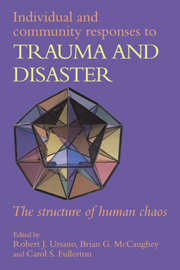Book contents
- Frontmatter
- Contents
- List of contributors
- Foreword
- Preface
- Part I Introduction
- Part II The nature of traumatic stress
- Part III The role of psychosocial context in responses to trauma and disasters
- Part IV Responses to trauma across the life cycle
- 13 Children of war and children at war: child victims of terrorism in Mozambique
- 14 Stress and coping with the trauma of war in the Persian Gulf: the hospital ship USNS Comfort
- 15 Long-term sequelae of combat in World War II, Korea and Vietnam: a comparative study
- 16 Psychophysiological aspects of chronic stress following trauma
- 17 Individual and community reactions to the Kentucky floods: findings from a longitudinal study of older adults
- Part V Conclusions
- Index
15 - Long-term sequelae of combat in World War II, Korea and Vietnam: a comparative study
from Part IV - Responses to trauma across the life cycle
Published online by Cambridge University Press: 13 October 2009
- Frontmatter
- Contents
- List of contributors
- Foreword
- Preface
- Part I Introduction
- Part II The nature of traumatic stress
- Part III The role of psychosocial context in responses to trauma and disasters
- Part IV Responses to trauma across the life cycle
- 13 Children of war and children at war: child victims of terrorism in Mozambique
- 14 Stress and coping with the trauma of war in the Persian Gulf: the hospital ship USNS Comfort
- 15 Long-term sequelae of combat in World War II, Korea and Vietnam: a comparative study
- 16 Psychophysiological aspects of chronic stress following trauma
- 17 Individual and community reactions to the Kentucky floods: findings from a longitudinal study of older adults
- Part V Conclusions
- Index
Summary
Introduction
In the years since the conclusion of the Vietnam conflict, mental health clinicians and social scientists have vigorously pursued the study of what was initially termed post-Vietnam stress syndrome. Pressed by urgent questions concerning the prevalence and etiology of psychological adjustment problems among Vietnam veterans, great strides have been made in the diagnosis, psychometric assessment, and treatment of the psychological sequelae of combat exposure in Vietnam.
A critical event in the study of war zone stress was the development of the diagnosis of Posttraumatic Stress Disorder (PTSD) for the third edition of the American Psychiatric Association's Diagnostic and Statistical Manual (American Psychiatric Association, 1980). Two features of this newly defined diagnostic entity were of particular importance. First, PTSD was conceptualized as a reaction to any type of extreme stress, not just to combat experience. Secondly, the cardinal features of the syndrome were identified in operational terms, encouraging empirical studies of the prevalence and presentation of the disorder in diverse populations.
The importance of comparative studies of PTSD
Although one of the distinctive features of the conceptualization of PTSD was its applicability to many types of traumatic experience, the preponderance of studies of PTSD among war veterans has focused on combat veterans of the Vietnam war.
- Type
- Chapter
- Information
- Individual and Community Responses to Trauma and DisasterThe Structure of Human Chaos, pp. 330 - 359Publisher: Cambridge University PressPrint publication year: 1994
- 9
- Cited by



